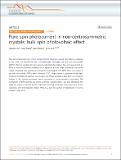Pure spin photocurrent in non-centrosymmetric crystals: bulk spin photovoltaic effect
Author(s)
Xu, Haowei; Wang, Hua; Zhou, Jian; Li, Ju
DownloadPublished version (1.573Mb)
Publisher with Creative Commons License
Publisher with Creative Commons License
Creative Commons Attribution
Terms of use
Metadata
Show full item recordAbstract
<jats:title>Abstract</jats:title><jats:p>Spin current generators are critical components for spintronics-based information processing. In this work, we theoretically and computationally investigate the bulk spin photovoltaic (BSPV) effect for creating DC spin current under light illumination. The only requirement for BSPV is inversion symmetry breaking, thus it applies to a broad range of materials and can be readily integrated with existing semiconductor technologies. The BSPV effect is a cousin of the bulk photovoltaic (BPV) effect, whereby a DC charge current is generated under light. Thanks to the different selection rules on spin and charge currents, a pure spin current can be realized if the system possesses mirror symmetry or inversion-mirror symmetry. The mechanism of BSPV and the role of the electronic relaxation time <jats:inline-formula><jats:alternatives><jats:tex-math>$$\tau$$</jats:tex-math><mml:math xmlns:mml="http://www.w3.org/1998/Math/MathML">
<mml:mi>τ</mml:mi>
</mml:math></jats:alternatives></jats:inline-formula> are also elucidated. We apply our theory to several distinct materials, including monolayer transition metal dichalcogenides, anti-ferromagnetic bilayer MnBi<jats:sub>2</jats:sub>Te<jats:sub>4</jats:sub>, and the surface of topological crystalline insulator cubic SnTe.</jats:p>
Date issued
2021-07Department
Massachusetts Institute of Technology. Department of Nuclear Science and Engineering; Massachusetts Institute of Technology. Department of Materials Science and EngineeringJournal
Nature Communications
Publisher
Springer Science and Business Media LLC
ISSN
2041-1723